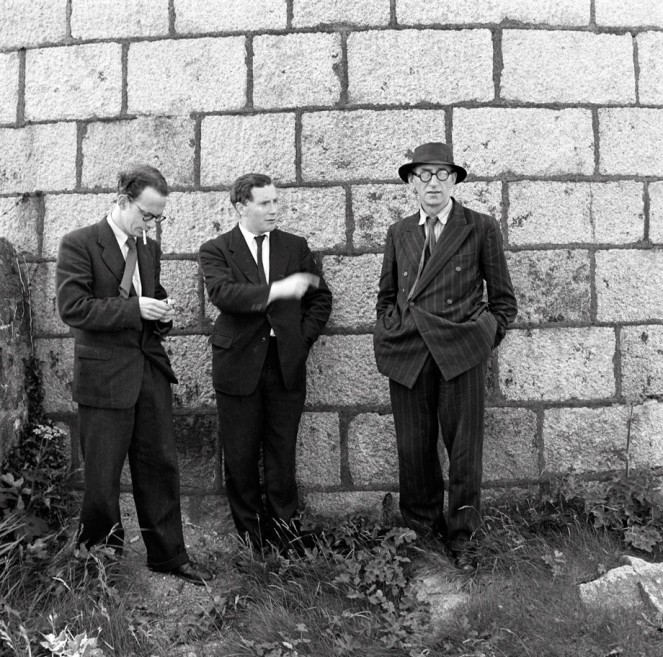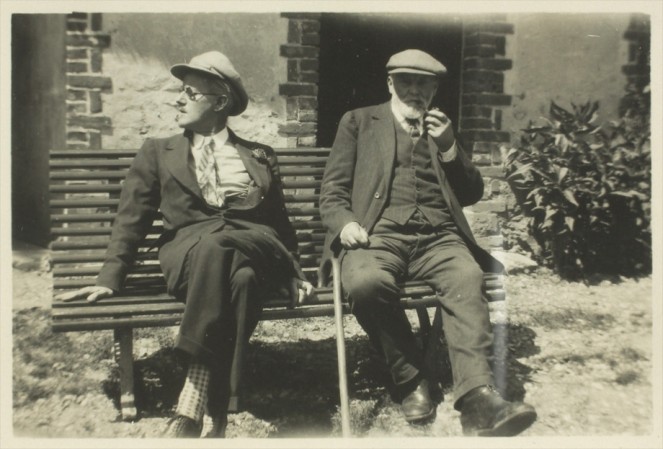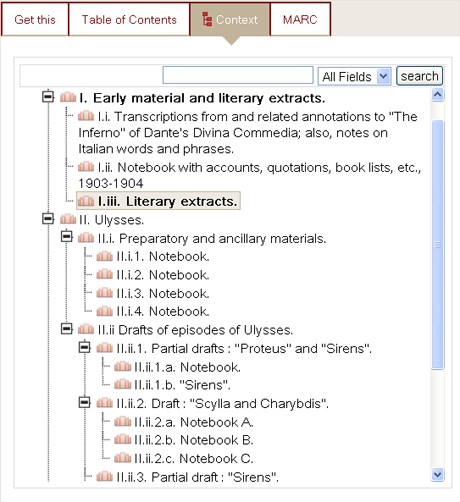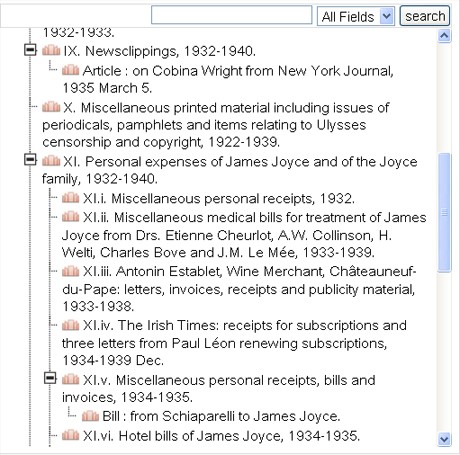by Catherine Ryan, Digital Collections Student
Bloomsday
On the 16th of June, 1954 the first Bloomsday was celebrated in Ireland. Flann O’Brien, Patrick Kavanagh, Anthony Cronin, Tom Joyce and John Ryan met in Dublin to trace the Ulysses route, starting at the Martello Tower in Sandycove through Sandymount Strand and on towards the shadier parts of the city that Joyce called Nighttown. They travelled around Dublin in horse-drawn cabs and enormous boots, playing their assigned roles from Ulysses, singing sentimental songs and generally drinking so much in comfortable pubs that they failed to make it to the brothels (according to Peter Costello in Flann O'Brien: An Illustrated Biography). Today, Bloomsday is celebrated in Ireland and around the world with much the same spirit, if somewhat fewer brothels, as fans of Ulysses engage in re-enactments, readings, performances and pub-crawls all in tribute to James Joyce.

Celebrating the first ever Bloomsday on Wednesday, 16th June 1954 - Anthony Cronin, John Ryan and Patrick Kavanagh at the Martello Tower, Sandycove, Dublin. NLI ref.: WIL pk 11(9)
The Project
The team here at Library Towers has also been preparing something very special in tribute to James Joyce and all of our readers. Over the past while the National Library of Ireland has been developing its enhanced catalogue and what better way to demonstrate its capabilities than with one of its most important collections, the James Joyce manuscripts. After a long time of planning, organising, cataloguing, digitising, building the technical infrastructure, testing and re-testing, the Library can happily announce that many of the literary and personal manuscripts of James Joyce in its possession are now available online.
It took a while and great effort to get to this point, with staff from across the NLI each contributing to the project in their own area of expertise. The complete list of Joyce manuscripts here at the National Library was analysed, as were any existing finding aids (the detailed lists of collection contents). With much welcome advice from the Manuscripts team, the materials were then catalogued – a mix of both original cataloguing where no detailed finding aids existed, and a conversion project where information from the finding aids was mapped and hundreds of online records created for each item and branch of an archive. To give examples of the latter, findings aids existed for the two largest collections, the Joyce Papers 2002 (Collection List No. 68) compiled by Peter Kenny and the Joyce-Léon Papers (The James Joyce-Paul Léon Papers: A Catalogue) compiled by Catherine Fahy. All the information found in each can now be viewed online, either in individual records or in context as part of an archival tree. I was assigned the task of creating the new records based on these lists so any typos (and other grievous errors) are my own!
But what is an enhanced catalogue without a few pretty pictures? Well, thanks to the team in the NLI’s digital studio we now have more than a few images to accompany the Joyce catalogue records. During and after the cataloguing process, the digital team spent a number of weeks digitising and preparing images for individual letters and literary notebooks in the collections. Each image had then to be renamed by the digital studio team according to how it was to be displayed on the catalogue, be it a single item or part of a bound notebook. While a number of items from the collections could not be digitised and existing images cannot be viewed in some countries due to copyright restrictions, catalogue records still exist for these materials and you can view these records on the enhanced catalogue.

James Joyce with Clovis Monnier, father of Adrienne Monnier, who published the French translation of <a href="http://www.flickr.com/photos/yournlireland/sets/72157626723856326/detai…; target="_blank" rel="nofollow">Ulysses</a>
The Catalogue (Beta Release!)
So, we had the records and the images. But we (and you!) needed more. As part of the NLI’s Digital Library Infrastructure Programme, our Information Systems team had already spent many months working on the development of an enhanced catalogue and the implementation of a digital repository to manage all of our digital content. The completion of this work was fast tracked so as to be ready in time for a beta release in advance of Bloomsday. A number of new features have been implemented allowing for an improved user experience of the catalogue and these are currently being showcased by the Joyce manuscripts. One of the most important of these features are the new image viewers which allows users to zoom in on more high resolution images and to see every little detail more clearly than ever before. Individual letters and items with only a few pages can be rotated while bound volumes with multiple pages can be viewed a page at a time or all together using the thumbnail view. Full screen view is available for all items and if you look carefully you can see that watermarks are present in each image at each zoom level as a security measure.
Another significant change in the catalogue is the introduction of the context view. This view displays all catalogued items as they appear in relation to one another in an archive, ensuring that each archive retains its context and that all items in the archive are understandable as part of a whole. The context view can be found under the ‘Context’ tab in each record and it displays all the records in an archival tree view. In addition to this, a wonderful feature has been added on the right hand side of the archival tree – if you click on any item in the archival tree, the image and information on that item will appear allowing you to view the context, image and item level information on-screen together. Like the image viewers, this is a feature that will be rolled out across all of our collections where appropriate so if you see a ‘View Context’ link in your catalogue searches be sure to have a look!
It is very much a beta release, which means that any creases will be ironed out in scheduled releases later this year as new features are rolled out across all the collections. In the meantime, feel free to try out the new features with some of the newly catalogued and digitised Joyce manuscripts described below.
The Joyce Manuscripts
The Joyce Papers 2002
The Joyce Papers 2002 contain notebooks, workbooks and other manuscripts, including early notes and drafts for Ulysses. These notebooks contain drafts for nine separate episodes of Ulysses and among them are some of the earliest sets of notes for Ulysses and are, according to Professor Michael Groden in the James Joyce Quarterly (Fall, 2001) “the most important collection of early drafts for Ulysses in the world.” The Joyce Papers 2002 also contain translations that Joyce made of Dante’s Inferno in the early 1900s as well as galley proofs for Finnegans Wake. This wonderful archive of material was listed in 2002 by Peter Kenny, Assistant Keeper in the National Library, in Collection List No. 68. This list has now been transferred online and the corresponding images attached. It can be viewed though the NLI’s catalogue.

Screenshot of a hierarchical tree from our catalogue showing Context View for the James Joyce Papers 2002, c. 1903-1928
The James Joyce-Paul Léon Papers
The Joyce-Léon Papers were donated to the NLI by Paul Léon in 1941 following James Joyce’s death and were placed under a fifty year seal as a condition of the donation. Joyce and Paul Léon had become close friends in the late 1920s and Léon took over Joyce’s business affairs to the point where he was secretary, agent and legal advisor. The Joyce-Léon Papers, which comprises mostly of correspondence, is a remarkable record of their personal and business dealings from 1930 to 1940. It includes letters between Joyce, Léon, Harriet Shaw Weaver (Joyce’s patron), other business associates, acquaintances, admirers and friends. These letters cover themes that preoccupied Joyce in the last decade of his life including the publication of Ulysses in America and England, the writing of Finnegans Wake, and his daughter Lucia’s health. In 1992 the collection was listed in full by Catherine Fahy, now Keeper of Research, Preservation and Conservation in the Library, in The James Joyce - Paul Léon Papers: a Catalogue. The collection itself has been partially digitised with those letters written or annotated by Joyce, mainly to Paul Léon, now available online. The remainder of the collection can be viewed on microfiche in the Department of Manuscripts.

Screenshot of a hierarchical tree from our catalogue showing Context View for the James Joyce - Paul Léon Papers, 1930-1940
Other Joyce Manuscripts
We have also catalogued and digitised a number of items from James Joyce to other prominent cultural figures of the day. These include poet and playwright Padraic Colum, who was one of the leading figures in the Irish Literary Revival; musician and composer Geoffrey Molyneux Palmer , who was the first to set Joyce’s poems to music; Richard Irvine Best, Celticist and librarian here at the National Library of Ireland; and Stephen Gwynn, an intellectual and politician involved in the cultural revival movement.
Bean an Phoist says: Don't forget that we have a lot of Joycean material at the National Library besides these manuscripts! Here's a tiny sample...

